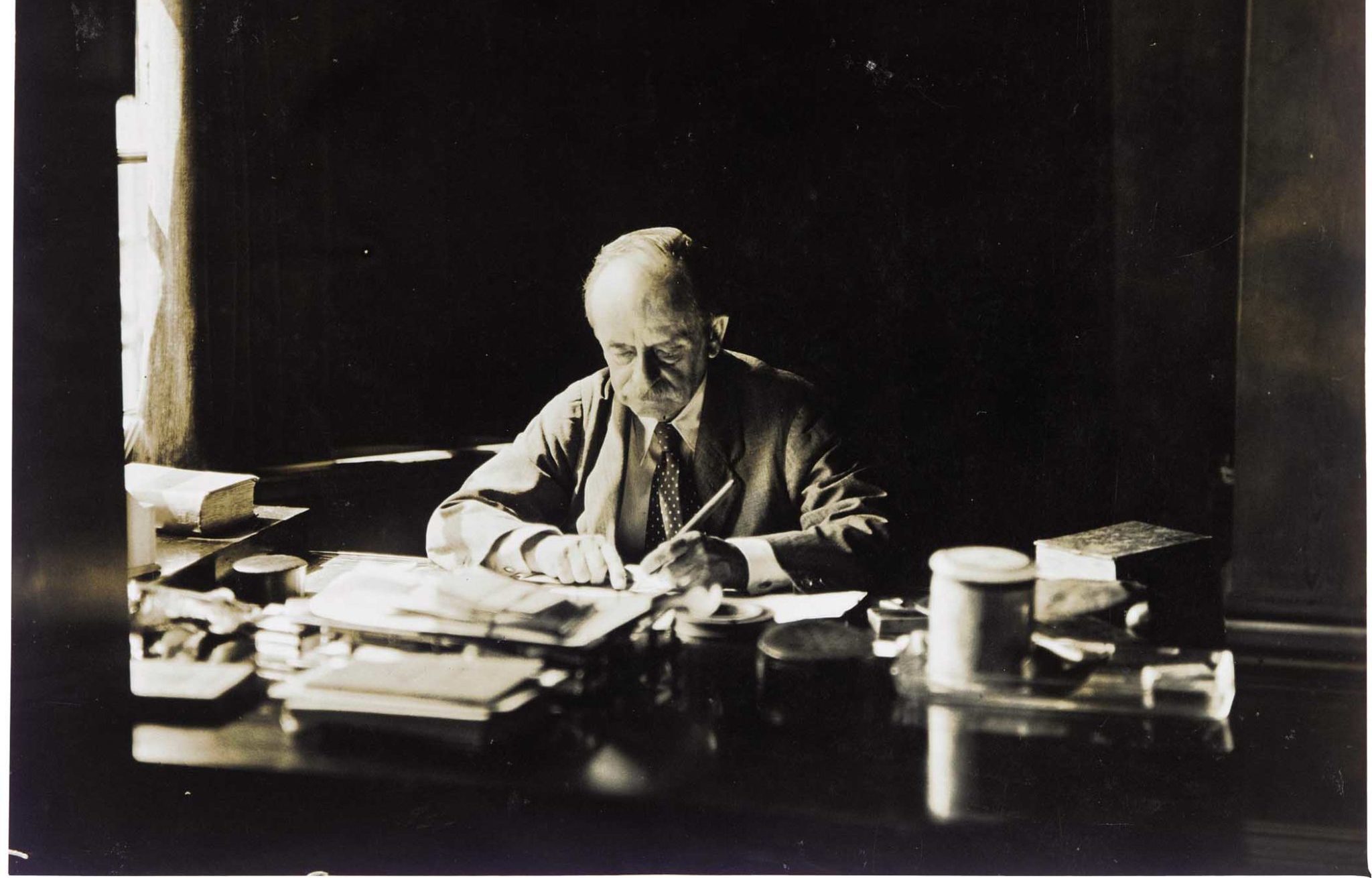J.M. Barrie writing letters to his great friend Robert Louis Stevenson at his desk in Adelphi Terrace House. (Sotheby’s via Getty Images)
Never-seen-before letters reveal JM Barrie telling Robert Louis Stevenson “I have discovered that I love you” – and the only possible explanation is that they were “the greatest of friends”.
It’s the first time that the letters from Peter Pan author Barrie to Stevenson have been read, after they were discovered in a dusty box of letters in an archive at Yale University.
The pair started writing to each other in 1892; they were both Scottish, but Stevenson, who was older and had already published Treasure Island when they began talking, lived on the island of Samoa to improve his health.
A year into their friendship, Barrie wrote to him: “To be blunt I have discovered (have suspected it for some time) that I love you, and if you had been a woman…” The rest of the sentence is unfinished.
After Stevenson died in 1894, his letters to JM Barrie were published. But Barrie’s side of the correspondence has been lost for more than a century. His letters, some of which run to 3,000 words long, include a declaration of love, wishing that he would meet Stevenson (the two never did meet), and fantasising that the pair were actually distantly related in order to open up to Stevenson about his close relationship with his mother.
Sounds to us exactly like the letters two heterosexual men would write to each other. Dr Michael Shaw, the University of Stirling lecturer who discovered the new letters and will soon publish a book about them called A Friendship in Letters, told the Observer that the friendship between Barrie and Stevenson had inspired Peter Pan.
“What’s revealed in these letters – and it took me a while to discover the full extent of this – is the influence that both Stevenson and the correspondence have on Barrie,” said Shaw. “In reading over Barrie’s works, I started to see allusions to the letters and to Stevenson that I hadn’t noticed before.
“He’s incorporating aspects of the correspondence into his own works, into his poetry and novels, and their friendship is also inspiring his works.
“I think what JM Barrie is saying is: if I can never meet Stevenson, because he has unfortunately died, then I want to create the opportunity for our characters to meet.
“I think he liked that idea that they could occupy the same world, and could potentially bump into each other.”
While we will never know what Barrie’s intentions were, with the declarations of love and everything, gay Twitter did not hesitate to recognise the queer yearning nor claim the literary pair as a historical gay romance.
“Victorian male author writer to Victoria male author ‘I want to fuck you’ (in Victorian),” one Twitter user wrote. “‘Deep respect’ is one way of putting it, I suppose.”
“Let people be queer,” another added.
Victorian male author writes to Victorian male author “I want to fuck you” (in Victorian).
“Deep respect” is one way of putting it, I suppose. https://t.co/8uHMldSeMr
— Philip Hensher (@PhilipHensher) October 25, 2020
“To be blunt I have discovered (have suspected it for some time) that I love you, and if you had been a woman…”
Yep. ‘Mutual affection’. Just friends. #LetPeopleBeQueer https://t.co/e1WPnHbXvm
— UndeadRobins (@UndeadRobins) October 25, 2020
‘Barrie wrote to him: “To be blunt I have discovered (have suspected it for some time) that I love you, and if you had been a woman…” He leaves the sentence unfinished.’ 🥺🥺
‘JM Barrie, who shared a deep friendship with Robert Louis Stevenson’ 🧐🤨https://t.co/Sra8e86GJn
— Sam Giles (@GilesPalaeoLab) October 25, 2020
They were *great friends*.
‘A year into their friendship…Barrie wrote to him: “To be blunt I have discovered (have suspected it for some time) that I love you, and if you had been a woman…” He leaves the sentence unfinished.’https://t.co/gB7hnC4V4I
— ✨🔮hex appeal🔮✨ (@Sorrelish) October 25, 2020
It is 2020, and we STILL have academics and journalists parsing 1890s phrases like “To be blunt I have discovered (have suspected it for some time) that I love you, and if you had been a woman…”
as
“mUtUaL aFfEcTioN”
“fRieNdShiP”
“bELovED fRiEnD”https://t.co/HQXCtJIzwE
— John Walton 🏳️🌈🇪🇺 (@thatjohn) October 25, 2020
Someone tell me before my knee jerks totally off its hinge: is there ANY reason why what sounds UNAMBIGUOUSLY like gay love is being presented like we’re back in 1903? Am I missing any crucial evidence establishing this as just ‘respect’ and ‘friendship’?https://t.co/uLgAj9uQIC
— Noreen Masud (@NoreenMasud) October 25, 2020
Yes, I always find myself saying “I love you, and if you had been a woman…” to those I ‘deeply respect’ 🙄
How much more blatant do these ‘greatest of friends’ need to be?!https://t.co/udl5vQfKld
— Conor McKeever (@conor_mckeever) October 25, 2020
It is not the first time that LGBT+ history has been erased from under our noses.
Last year, two ancient Roman skeletons that had been buried holding hands and were nicknamed the “Lovers of Modena’” were downgraded to “siblings or cousins or soldiers who died together in battle” once archaeologists discovered that both the skeletons were men.
And scientists were baffled again last year, when they realised there was a “female” skeleton in a historically all-male monastic republic in Greece.
Researchers were stumped. How could a “female” have gotten into the byzantine chapel?
Yet again, it took a number of Twitter users to point out that trans people have existed throughout history and the possibility that the person was trans should not be crossed out.
